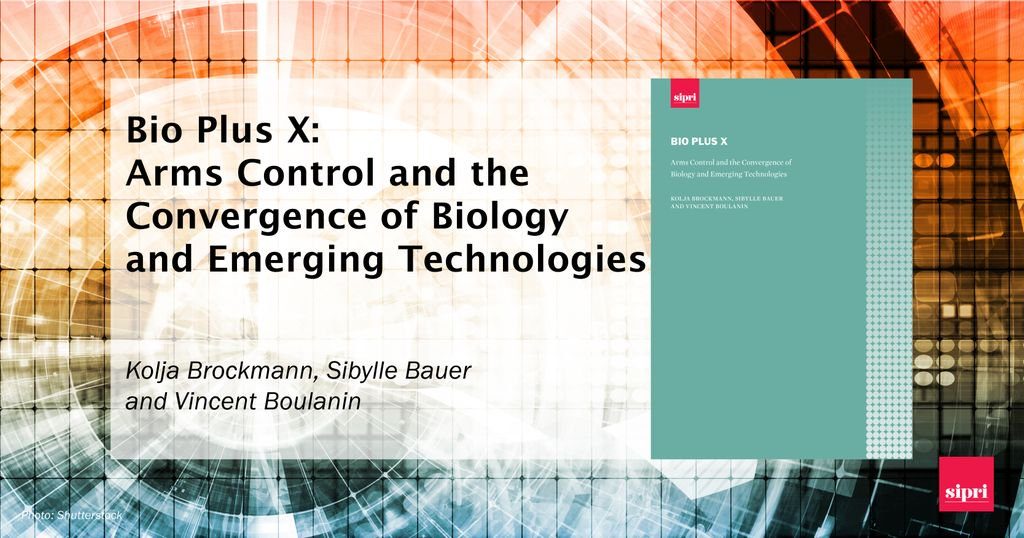Additive manufacturing and 3D bioprinting have been featured in a new risk report from the Stockholm International Peace Research Institute (SIPRI). Titled BIO PLUS X, this report assesses “Arms Control and the Convergence of Biology and Emerging Technologies” namely 3D printing, artificial intelligence (AI) and robotics.
A clearly knowledgeable and in-depth consideration of a variety of 3D printing technologies and their limitations, the risks considered in the SIPRI report are no cause for alarm. However, along with the other technologies taken into consideration, 3D printing does come with a number of recommendations to assure its proper use. As Dr. Sibylle Bauer, report co-author and Director of the SIPRI Armament and Disarmament programme, states:
“A key challenge for effective biological arms control is that treaty structures and the institutional arrangements in ministries and government agencies do not correspond to today’s technical realities.”

Because prevention is cheaper (and safer) than the cure
BIO PLUS X is a report written on the basis of “what if?” i.e. it’s not the fact that these technologies are currently being used to develop biological weaponry, but instead the thought that there should be policies in place in case of that eventuality. Kolja Brockmann, SIPRI researcher and lead author of the report, comments, “Each of these technologies could, in its own way, facilitate the development, production and use of biological weapons, and make them more dangerous.”
Where 3D printing is concerned, the authors state “the interaction and convergence of biotechnology and additive manufacturing currently only produce moderate risk of proliferation of biological weapons.”
“Nonetheless,” they add, “it is necessary for the arms control community to monitor these developments and consider appropriate governance measures.”
Though a variety of 3D printing methods are considered by the institute, at present only three applications are deemed of “particular concern.” These are:
(a) the printing of production or laboratory equipment;
(b) bioprinting; and
(c) the printing of delivery systems or their components, i.e. drones
Though these areas have been flagged by SIPRI, the overwhelming fact remains that other, already well-established, methods are easier to access, more effective and more readily available for the purpose of producing biological weaponry.
One important differentiation made by the authors is that “AM does not deliver specialized high-end products ‘at the touch of a button’ but
involves a process whose different stages require a variety of skills.”
In the case of lab equipment the authors explain that additional hurdles, such as process development, would outweigh the effort expended to achieve an end-use product.
Further, “[3D bioprinting] techniques are not uniquely enabling; established methods, such as animal testing, are currently more accessible and require a more common set of skills.”
And for drones, it is a similar story: “[…] other less technologically sophisticated production pathways are available to non-state actors.”
How can we protect against malicious activity?
In order to prevent the possibility that 3D printing becomes a viable option for advancing biological weaponry, the BIO PLUS X report calls for new policies to be put in place. To be applied across several levels, from national governments to the DIY community, SIPRI broadly calls for more systematic monitoring of tech developments; heightened awareness; and self-regulation from the private sector.

A detailed list of SIPRI recommendations can be found online here in the full BIO PLUS X report. The report is co-authored by Kolja Brockmann, Sibylle Bauer and Vincent Boulanin.
The application of 3D printing as a threat to national security is also the subject of a current export control review by the U.S. Bureau of Industry and Security. In the most recent update on this case, several 3D printing industry stakeholders, including Carbon and Stratasys, have expressed concerns that further regulation, beyond existing export controls, could have a detrimental effect on R&D excellence within the U.S.
For more of the latest 3D printing legal and regulatory news subscribe to the 3D Printing Industry newsletter, follow us on Twitter and like us on Facebook. Seeking jobs in engineering? Make your profile on 3D Printing Jobs, or advertise to find experts in your area.
Featured image shows the BIO PLUS X: Arms Control and the Convergence of Biology and Emerging Technologies report, published by SIPRI. Image via the Stockholm International Peace Research Institute


